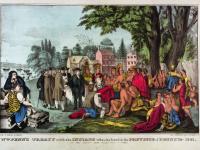Answer: Under an elm tree
Legend says that shortly after William Penn’s arrival in the new Province of Pennsylvania in 1682, he met a group of Native Americans, the Lenni Lenape, in an area on the Delaware River under an elm tree. This area known as Shackamaxon was “neutral ground” among the Native American tribes, where they would fish, hunt, as well as exchange wampum belts of treaty. There they formed a Treaty of Friendship with William Penn, and the elm tree became a symbol for this peaceful event.
The elm tree, or "Great Elm" as it was known, was immortalized in works by artists such as Thomas Birch and Benjamin West, and it stood on the banks of the Delaware for more than 120 years. In March of 1810, the tree was brought down during a large storm; but it was not forgotten. Objects were created from the wood of the fallen elm, including a box that was made for Chief Justice John Marshall in 1831 of which he said: “The box is to me an inestimable relique. I know no inanimate object more entitled to our reverence than the tree of which it was a part, because I think few events in history have stronger claims on our serious reflection, on our humanity, our sense of rights, and on our judgement, than the treaty which was made under it, and the consequences which followed that treaty…” In the tree’s place an obelisk was erected in 1827. Today, in the current day Penn Treaty Park located just north of Penn's Landing, a monument to William Penn recalls the event and the tree.
Image: "William Penn's treaty with the Indians whom he founded the Province of Pennsylvania, 1681,” lithograph published by N. Currier after painting by Benjamin West

